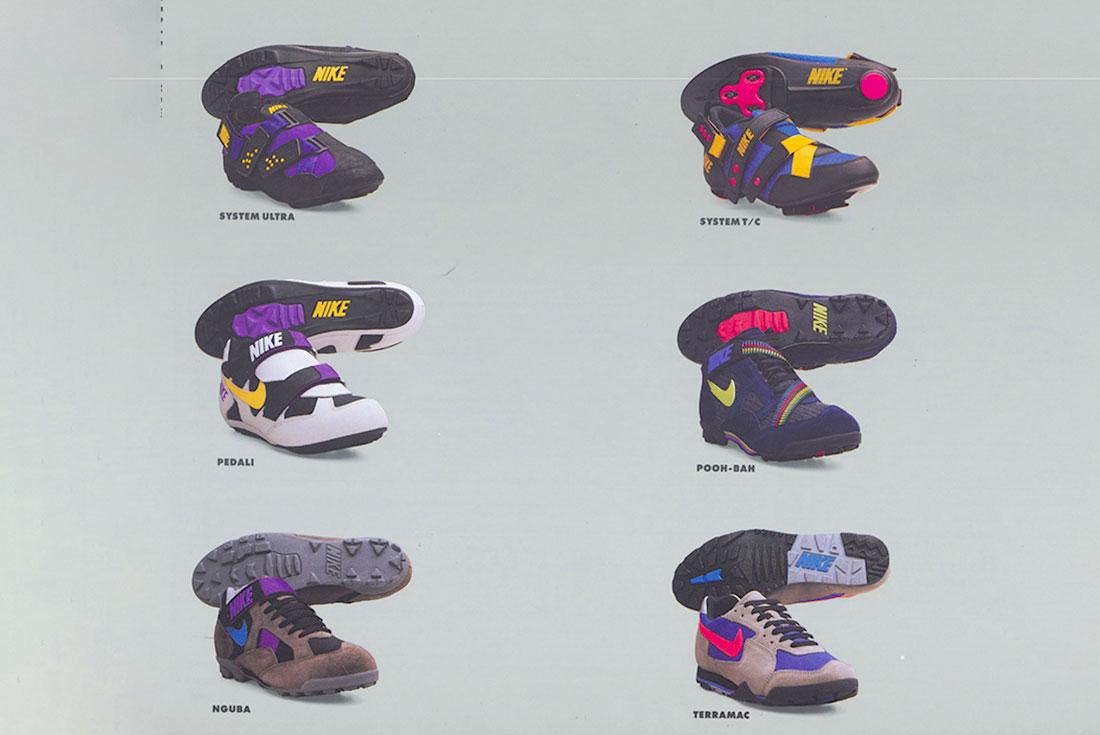Cycling experienced its largest uptake in the US between 1965 and 1975, a period referred to as the ‘bike boom’. Time Magazine proclaimed it was ‘the bicycle’s biggest wave of popularity in its 154-year history’. After the boom settled down, and cycling was a widely accepted sport and pastime, many sportswear companies got in on the action. Nike was a fairly prominent player between the 80s and early 2000s, with an extensive line of cycling-specific performance products.
It wasn't until 2019 that Nike swung a leg over the top tube again to offer new cycling designs. With a storied history in the sport, there is so much the Swoosh can still re-engage with. This is a brief history of Nike Cycling.




By the middle of the decade, Nike already had cleverly-named styles like the Pooh-Bah, a mid-cut shoe with lockdown straps coloured in the Union Cycliste Internationale’s (UCI) world champion rainbow bands. It also helped that off-road rockstar John Tomac was wearing them. As the 90s rolled on, Shimano’s two-bolt SPD recessed cleat gained popularity in the MTB world: Nike followed suit with two-bolt compatibility on successive styles like the Supa Pooh-Bah and Nguba 2. At this point, it was the late 90s and most cycling-ready Nike footwear was ACG. Three-bolt road shoes also sat under this umbrella.
Then, in 2018, Cavendish posted a pair of Nike cycling shoes in the same colourway as the OG Mercurial R9 from 1998.
In his own words, it was a Mercurial Superfly 360 with an added ankle strap. Could Nike just put carbon soles on Mercurial boots to make cycling shoes? It appeared simple enough, as many top-end football boots use carbon soles. It wasn’t the first modified Mercurial boot Cavendish had been riding, either.
At the same time, out of the blue, English rider Blythe also posted his own custom Nike cycling shoes.
Mercurials again! One-of-ones, modelled on the Off-White Mercurial collaboration, but with BOA closures instead of laces. Blythe is also a prolific owner of other custom Nike cycling shoes: a deep trawl of his Instagram reveals at least half a dozen colourways at his disposal. Yet, Nike don’t currently have any publicly-available cycling products, despite Blythe using Nike shoes from as far back as 2012.
Mention has to be made to Biketown, Portland’s public bike share program. Guess who else is based in Portland? In 2016, Nike began investing $10 million over the next five years into Biketown. This investment sees an increase in available bikes, infrastructure, and limited edition bike frame wraps in iconic Nike motifs.
An Unofficial Return?
At the end of 2019, Nike announced the line of fitness focussed footwear. One astute and exciting observation was the , a new silhouette developed for indoor cycling!
The Swoosh have clearly tapped into their previous experience, designing a sleek-looking spin shoe with modern branding and practical cyclist features, like the rubberised heel and toe studs to prevent slipping. They release in June 2020.
While this doesn't mark an official revival of Nike Cycling, it's a promising sign that there might be more options for sneakerheads who like to travel on two wheels!
Is it Time for Nike to Get Back Into the Peloton?
Sooner or later, the public will forget about the Armstrong saga. Riders are still rolling with their soon-to-be vintage Poggios at the risk of the soles falling off. And, at the pro level, Cavendish and Blythe are stoking fans’ fires. As a guarantee, if the Swoosh revive their cycling line – and perhaps call it Echelon – they’ll have at least one very loyal customer.